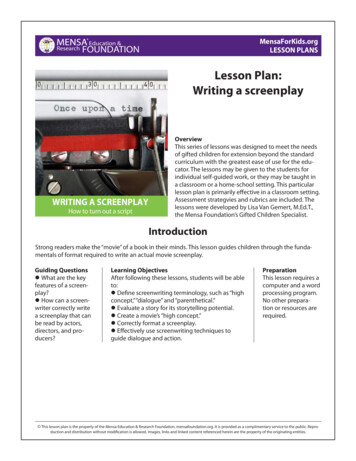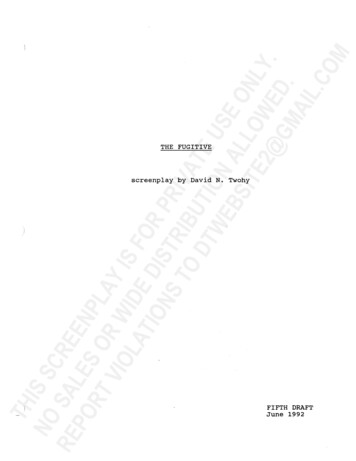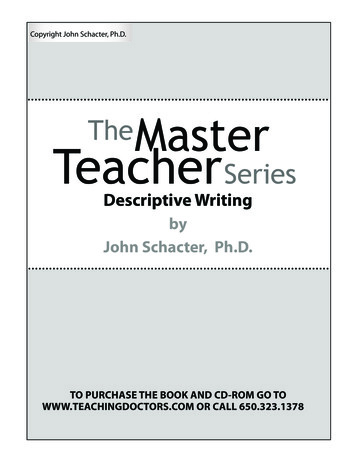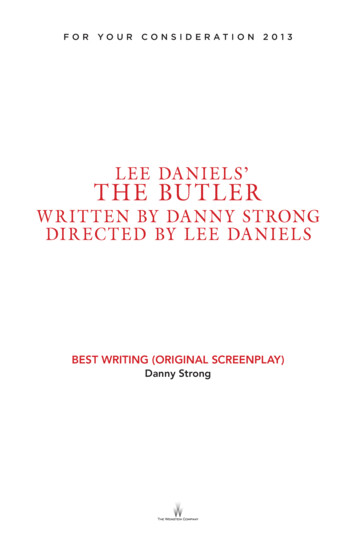
Transcription
Lesson Plan:Writing a screenplayOverviewThis series of lessons was designed to meet the needsof gifted children for extension beyond the standardcurriculum with the greatest ease of use for the educator. The lessons may be given to the students forindividual self-guided work, or they may be taught ina classroom or a home-school setting. This particularlesson plan is primarily effective in a classroom setting.Assessment strategvies and rubrics are included. Thelessons were developed by Lisa Van Gemert, M.Ed.T.,the Mensa Foundation’s Gifted Children Specialist.IntroductionStrong readers make the “movie” of a book in their minds. This lesson guides children through the fundamentals of format required to write an actual movie screenplay.Guiding Questionsl What are the keyfeatures of a screenplay?l How can a screenwriter correctly writea screenplay that canbe read by actors,directors, and producers?Learning ObjectivesAfter following these lessons, students will be ableto:l Define screenwriting terminology, such as “highconcept,” “dialogue” and “parenthetical.”l Evaluate a story for its storytelling potential.l Create a movie’s “high concept.”l Correctly format a screenplay.l Effectively use screenwriting techniques toguide dialogue and action.PreparationThis lesson requires acomputer and a wordprocessing program.No other preparation or resources arerequired. This lesson plan is the property of the Mensa Education & Research Foundation, mensafoundation.org. It is provided as a complimentary service to the public. Reproduction and distribution without modification is allowed. Images, links and linked content referenced herein are the property of the originating entities.
Lesson 1: PrologueIf you like to read and you like to watch movies, you’ve probably thought that you could write a movieyourself. Have you? Be honest! In this lesson, you’ll learn the very basics of screenwriting in a nutshell. Thereis much more to learn, obviously, but this will get you pointed in the right direction.Before you go any further, the first thing you need to do is look at a real screenplay to get an idea of whatthey look like. Here are a few examples: Shakespeare’s Romeo and Juliet (goo.gl/qe8hbg)The African Queen, by James Agee, John Huston, and Peter Viertel (goo.gl/tDYTmC)Who Shot Roger Rabbit?, by Jeffrey Price and Peter S. Seaman (goo.gl/VLcKMH)The Lion King, by Irene Mecchi and Jonathan Roberts (goo.gl/b985Ke)Did you notice how the formatting didn’t read like a book? Screenplays are written using a specific format.People who write screenplays professionally use specific software, and if you become serious about it, youcan invest in that, too. Some commonly used screenwriting software products include: Literature & Latte’s Scrivener (goo.gl/RV4N3Y) [paid]Final Draft (goo.gl/pMRngY) [paid]Writer Duet (goo.gl/vBxt6d) [free]Professional screenwriting software is pretty expensive, but you don’t need it to start writing. All you need isthe know-how and a story to tell. Ready? This lesson plan is the property of the Mensa Education & Research Foundation, mensafoundation.org. It is provided as a complimentary service to the public.Reproduction and distribution without modification is allowed. Images, links and linked content referenced herein are the property of the originating entities.2 Mensa Foundation Lesson Plan: WRITING A SCREENPLAY
Lesson 2: Action! (steps 1-4)STEP 1: The story – First, you need to choose your story. It can be a long chapter book or a shorter picturebook you love. It can be a comic strip you like to read. It can be a story you made up. A good story will havestrong characters and make you feel something for what’s going on. What story are you going to use?STEP 2: The concept – Next, describe your story’s “high concept.” This is the term they use in Hollywood tomean what the main idea of your story is. Put it in a “what if” format. For instance, think about the movieMary Poppins. The “what if” statement would be “What if a nanny with magical powers came to take care ofthree children and changed their lives forever?” Write your “what if” statement here: This lesson plan is the property of the Mensa Education & Research Foundation, mensafoundation.org. It is provided as a complimentary service to the public.Reproduction and distribution without modification is allowed. Images, links and linked content referenced herein are the property of the originating entities.Mensa Foundation Lesson Plan: WRITING A SCREENPLAY 3
STEP 3: The document – Now let’s make a titlepage. Open a document.l Find the middle of the page, vertically andhorizontally. Type the title in bold type.l Two lines below the title, type “Written by”centered on the line.l Two lines underneath that, type yourname, also centered.l In the lower right-hand corner, put your name,address, phone number and email address.(Example at right.)ON THE RUNSTEP 4: The document format – Now you’reready to start your story. Before you begin,you have to format the page.This is important to do correctly if you wantto be taken seriously. However, there aremany standards out there for the “right” wayto format a script, usually dependent on whothe script will be submitted to. For our purposes here, we’re going to aim high and usethe standards used for the Academy Awards.Here’s what you do:Written bySusan A. RighterSusan A. Righter11100 Author WayMovietown, PA 22104susan@iwritemovies.coml Insert a page number in the upper right corner of the header. Make it so that the page number starts onthe second page with “2.” You don’t put a page number on the first page.l Use the font Courier in 12-point.l Set the margins as follows:u Top and bottom: 1”u Left margin: 1.5” (you have to leave extra on the left to allow for the hole punching)u Right margin: 1” This lesson plan is the property of the Mensa Education & Research Foundation, mensafoundation.org. It is provided as a complimentary service to the public.Reproduction and distribution without modification is allowed. Images, links and linked content referenced herein are the property of the originating entities.4 Mensa Foundation Lesson Plan: WRITING A SCREENPLAY
Lesson 3: Writing a scene (steps 5-11)STEP 5: Setting the scene – Now that you’ve got your document formatted, you’re ready to write. Youwill write in scenes. Scenes are pieces of the whole movie. Each scene has to establish who is in the scene,where it is, when it is and what is happening. What is happening is very important. There needs to be something happening in each scene. At the end of every scene, you should be able to answer the question “Sowhat?” with a response showing why that scene is important to the overall movie.STEP 6: The scene heading – First you need to give the scene heading. This tells where the action is takingplace and what time it is, as well as other information the director and actors need to know to make it comeout the way you, the writer, envision it.Type the scene heading left aligned. Left aligned means that the letters start at the far left of the page, justlike in this paragraph. Use all capital letters. First, you have to say if the scene is to be shot inside (interior,abbreviated “INT”) or outside (exterior, abbreviated “EXT”). Next, put a hyphen in and give the location. Isthe action taking place in a house, at an amusement park, in a library? Here are some examples:INT. BASEMENT – MIDDLE OF THE NIGHTEXT. BEACH – EARLY DAWNEXT. MALL PARKING LOT – LATE AFTERNOONSTEP 7: Adding action – You’re ready to write the action now. When we’re writing a screenplay, we usewhat is called the literary present tense. That means that we write as though whatever is happening in thescene is happening right now. We write in the present tense only and always. The first time you mentiona character’s name, put that name all in CAPITALS. Also put anything that makes a sound in caps. That letsscript readers easily see who’s there and what’s going on. Here’s an example:INT. BASEMENT – MIDDLE OF THE NIGHTDim light filters through high, narrow windows. Children lie sprawled asleep on filthy mattresses on thebare floor. KAREN DIAMOND, 25, is awake, sitting on the lowest step of the wooden staircase with her face inher hands. FOOTSTEPS are heard from the floor above.STEP 8: Adding characters – Now that you’ve brought your character into the scene, you probably will This lesson plan is the property of the Mensa Education & Research Foundation, mensafoundation.org. It is provided as a complimentary service to the public.Reproduction and distribution without modification is allowed. Images, links and linked content referenced herein are the property of the originating entities.Mensa Foundation Lesson Plan: WRITING A SCREENPLAY 5
want the character to speak. There are some rules for that. The character has to be introduced. You introduce the character by indenting his or her name 4.2 inches from the left edge of the paper.Here’s what we’ve got so far:INT. BASEMENT – MIDDLE OF THE NIGHTDim light filters through high, narrow windows. Children lie sprawledasleep on filthy mattresses on the bare floor. KAREN DIAMOND, 25, is awake,sitting on the lowest step of the wooden staircase with her face in herhands. FOOTSTEPS are heard from the floor above.KARENSTEP 9: Adding dialogue – Now that she’s been introduced, the character can talk! Talking in a movie iscalled dialogue. Dialogue uses different margins. It should go from 3 inches from the left edge of the paperto 2.5 inches from the right edge. Example:INT. BASEMENT – MIDDLE OF THE NIGHTDim light filters through high, narrow windows. Children lie sprawledasleep on filthy mattresses on the bare floor. KAREN DIAMOND, 25, is awake,sitting on the lowest step of the wooden staircase with her face in herhands. FOOTSTEPS are heard from the floor above.KARENWhat am I going to do with all these kids?Where are we going to go? How are we goingto get out of here alive?You as the writer may have an idea of how something should be said or some action that needs to be takingplace at the same time. This is called a “parenthetical” because you put it in parentheses. Parentheticals have This lesson plan is the property of the Mensa Education & Research Foundation, mensafoundation.org. It is provided as a complimentary service to the public.Reproduction and distribution without modification is allowed. Images, links and linked content referenced herein are the property of the originating entities.6 Mensa Foundation Lesson Plan: WRITING A SCREENPLAY
their own margin rules. (So many margin rules!) They are indented 3.7 inches from the left and 5.2 inchesfrom the right, for a total width of 1.5 inches. Don’t center them under the character’s name, even thoughthat looks better. Example:INT. BASEMENT – MIDDLE OF THE NIGHTDim light filters through high, narrow windows. Children lie sprawledasleep on filthy mattresses on the bare floor. KAREN DIAMOND, 25, is awake,sitting on the lowest step of the wooden staircase with her face in herhands. FOOTSTEPS are heard from the floor above.KAREN(sighing)What am I going to do with all these kids?Where are we going to go? How are we goingto get out of here alive?You might want your character to move while he/she is talking. To do that, you put the action in, and thenyou have to introduce your character all over again. You use this (CONT’D) after the name to show that thedialogue continues through the action. Example:KAREN(sighing)What am I going to do with all these kids?Where are we going to go? How are we goingto get out of here alive?Getting up from the steps, Karen walks over to one of the windows andstares out of it.KAREN (CONT’D)There’s got to be a way out of here. This alleyhas to lead somewhere.This shows that while she is getting up and looking out of the window, she is still talking.STEP 10: Voiceovers – Sometimes you may want your character to talk in a different way than straight dialogue. Maybe you want the action to continue while the character isn’t in the scene, but you can still hearhis/her voice. This is called “voiceover” and is abbreviated “V.O.” Maybe you want the character to be out ofrange of the camera, but still participating in the scene. This is called “off-screen” and is abbreviated “O.S.” This lesson plan is the property of the Mensa Education & Research Foundation, mensafoundation.org. It is provided as a complimentary service to the public.Reproduction and distribution without modification is allowed. Images, links and linked content referenced herein are the property of the originating entities.Mensa Foundation Lesson Plan: WRITING A SCREENPLAY 7
You show this the same way as you did (CONT’D) by putting an abbreviation to the right of the character’sname. Examples:KAREN (CONT’D)There’s got to be a way out of here. This alleyhas to lead somewhere.The children start to stir and Karen walks around, helping them get up.KAREN (V.O.)Impossible as it seemed, I knew then that ouronly hope lay down that dark alley.The “V.O.” shows the director and actor that the audience will hear her voice, but on the screen her lips won’tbe moving.STEP 11: Keeping the beat – If you want your character to pause between sentences or phrases, type inthe word “beat” like you would a regular parenthetical. Example:KAREN (V.O.)I knew then that our only hope lay down thatdark alley, as impossible as it seemed.(beat)And yet I knew deep down that everything tothis point had also been impossible. This lesson plan is the property of the Mensa Education & Research Foundation, mensafoundation.org. It is provided as a complimentary service to the public.Reproduction and distribution without modification is allowed. Images, links and linked content referenced herein are the property of the originating entities.8 Mensa Foundation Lesson Plan: WRITING A SCREENPLAY
Lesson 4: More techniques (steps 12-14)STEP 12: The montage – You may have a scene that is like a collage of images. In screenwriting, this iscalled a “montage.” To write the order of a montage, you start by typing “MONTAGE” in all caps left aligned.Then you number the scenes in the montage in order. You can use capital letters instead of numbers, too. Itdoesn’t matter. Example:MONTAGE1) KAREN kneels next to a small girl and gently pulls her hair back into apony tail.2) Karen stuffs her belongings into a ragged bag and stares around thebasement, the children gathered around her.3) Karen uses a broom handle to break the window above her, then lays ashirt across the bottom of the window sill.4) Karen lifts the children one by one through the window.5) When they are all out of the window, Karen looks around again, digs hertoe into the crumbling wall, and boosts herself through the jagged opening, cutting her arm.6) Empty basement with light growing brighter. This lesson plan is the property of the Mensa Education & Research Foundation, mensafoundation.org. It is provided as a complimentary service to the public.Reproduction and distribution without modification is allowed. Images, links and linked content referenced herein are the property of the originating entities.Mensa Foundation Lesson Plan: WRITING A SCREENPLAY 9
STEP 13: The intercut – Another technique you might need is called “intercut.” Intercutting is when youhave two different scenes going on at the same time. Maybe two characters are on the phone with eachother, or maybe two totally different action scenes are happening simultaneously. To do this, you establishthe scene in both places, then type “INTERCUT” against the left margin. Explain the intercut in all caps, andthen type the dialogue or action normally. Example:EXT. ALLEY – MORNINGKAREN is running down the alley holding two children by the hand while theothers follow.INT. BASEMENT – MORNINGThree MEN stand in the empty basement, looking around at the mattressesand broken window, guns drawn.INTERCUT BETWEEN KAREN WITH CHILDREN AND MENKaren turns off the alleyway onto a busy street and slows to a walk.The men run up the stairs.Karen sees a police car and heads towards it.The men run out of the house and around the back to the alley where theyfind a sweater dropped by one of the children.Karen sees the police officer and freezes in fear.The men run down the alley, looking down cross streets.STEP 14: Do it right! It is very important that you use perfect spelling and grammar. Have someone elsecheck it for you. Don’t rely on your computer program’s checker; it is not always accurate. Screenwriting is aserious business. If you want to be taken seriously, you can’t have misspelled words and poorly constructedsentences. This lesson plan is the property of the Mensa Education & Research Foundation, mensafoundation.org. It is provided as a complimentary service to the public.Reproduction and distribution without modification is allowed. Images, links and linked content referenced herein are the property of the originating entities.10 Mensa Foundation Lesson Plan: WRITING A SCREENPLAY
Lesson 5: Learning more (step 15)STEP 15: Practice, Practice, Practice! To practice, you need to do three things: read, watch, and write.l Read books on screenwriting; see the Extension section for suggestions.l Next, you need to watch movies carefully. Can you see the intercuts? When you hear dialogue, thinkabout what parentheticals you would use to make it sound like that. When you see a montage, think abouthow you would write that out.l Lastly, you need to write. No matter how good your idea is, it will never have what it takes to make a realmovie if it’s not turned into a script. Read, watch, write!If you finish a screenplay, check out copyright.gov to find out how to copyright it. This lesson plan is the property of the Mensa Education & Research Foundation, mensafoundation.org. It is provided as a complimentary service to the public.Reproduction and distribution without modification is allowed. Images, links and linked content referenced herein are the property of the originating entities.Mensa Foundation Lesson Plan: WRITING A SCREENPLAY 11
ExtensionBooksl Field, Syd. Screenplayl Flinn, Denny Martin. How Not to Write a Screenplay: 101 Common Mistakes Most Screenwriters Makel Hunter, Lew. Lew Hunter’s Screenwriting 434: The Industry’s Premier Teacher Reveals the Secrets of the Successful Screenplayl Iglesias, Karl. The 101 Habits Of Highly Successful Screenwriters: Insider’s Secrets from Hollywood’s Top Writersl Lazarus, Tom. Secrets of Film Writingl Press, Skip. The Complete Idiot’s Guide to Screenwritingl Straczynski, J. Michael. The Complete Book of Scriptwritingl Trottier, David. The Screenwriter’s Bible: A Complete Guide to Writing, Formatting, and Selling Your ScriptEtceteral screenwritersutopia.coml writerswrite.com/screenwritingl wordplayer.coml sydfield.com This lesson plan is the property of the Mensa Education & Research Foundation, mensafoundation.org. It is provided as a complimentary service to the public.Reproduction and distribution without modification is allowed. Images, links and linked content referenced herein are the property of the originating entities.12 Mensa Foundation Lesson Plan: WRITING A SCREENPLAY
AssessmentThe assessment for this lesson has two components. The first is a terminology quiz. The second is a rubric tobe used when the student creates a screenplay.Screenplay Writing Terminology Quiz1. The “what if”question that sayswhat the storyis about is calledwhat?A. basisB. high conceptC. story boardD. reason2. If a writer wantsthe director toswitch back andforth between onescene and another,he/she would usethis technique:A. switcherooB. intercessionC. montageD. intercut3. If a characteris speaking fromout of the scene,but is still in thescene, the writerwould use whichof the followingabbreviations?A. O.O.S.B. V.O.C. O.C.D. O.S.4. The writeruses which of thefollowing wordsto show that acharacter pausesin the middle oftalking:A. pauseB. resumeC. beatD. wait5. If the character is not in thescene but actionis going on andyou can hear thecharacter’s voicetalking, what isthe abbreviationused in the script?A. V.O.B. O.S.C. O.V.D. S.O.6. Look at the following script and find the errors. Line through each error and correct it.INT. – DECK of a boat at NIGHTSamantha leans over the railing of the boat. Foghorns blare on the water.JIM comes out of the cabin and stands next to her.JIM(whispering)Did you see Dad yet? I’ve been waiting forever.SAMANTHANo. I think he left with those men in the dinghy.Samantha stands up and starts walking toward the front of the boat. Jimfollows behind her.SAMANTHA (cont’d.)And I don’t think we’ll ever know why, Jim. Ireally don’t.MOTHER (V.O.)Samantha! Jim! Where are you? This lesson plan is the property of the Mensa Education & Research Foundation, mensafoundation.org. It is provided as a complimentary service to the public.Reproduction and distribution without modification is allowed. Images, links and linked content referenced herein are the property of the originating entities.Mensa Foundation Lesson Plan: WRITING A SCREENPLAY 13
Answer key1. B2. D.3. O.S.4. beat5. V.O.6. Errors in bold-italics and corrected:EXT. DECK OF A BOAT - NIGHTSAMANTHA leans over the railing of the boat. Foghorns BLARE on the water.JIM comes out of the cabin and stands next to her.JIM(whispering)Did you see Dad yet? I’ve been waiting forever.SAMANTHANo. I think he left with those men in the dinghy.Samantha stands up and starts walking toward the front of the boat. Jimfollows behind her.SAMANTHA (CONT’D)And I don’t think we’ll ever know why, Jim. Ireally don’t.MOTHER (O.S.)Samantha! Jim! Where are you? This lesson plan is the property of the Mensa Education & Research Foundation, mensafoundation.org. It is provided as a complimentary service to the public.Reproduction and distribution without modification is allowed. Images, links and linked content referenced herein are the property of the originating entities.14 Mensa Foundation Lesson Plan: WRITING A SCREENPLAY
Screenplay rubricCategory4321Grammar &Spelling(conventions)Writer makes noerrors in grammaror spelling thatdistract the readerfrom the content.Writer makes1-2 errors in grammar or spelling thatdistract the readerfrom the content.Writer makes 3-4errors in grammaror spelling thatdistract the readerfrom the content.Writer makes morethan 4 errors ingrammar or spelling that distractthe reader from thecontent.Flow &Rhythm(sentencefluency)All sentencessound natural andare easy on the earwhen read aloud.Each sentence isclear and has anobvious emphasis.Almost all sentencessound natural andare easy on the earwhen read aloud,but 1 or 2 are stiff,awkward, or difficultto understand.Most sentencessound natural andare easy on the earwhen read aloud,but several are stiff,awkward or difficultto understand.The sentences aredifficult to readaloud because theysound awkward,are distractingly repetitive, or difficultto understand.Story ChoiceWriter uses a vividstory that lingersin the reader’smind due to strongcharacters and lotsof action.Writer uses an acceptable story thathas fairly strongcharacters and amoderate amountof action.Writer uses amarginal story thathas stereotypicalcharacters and/ortoo little action.Writer uses a poorstory that has weakcharacters and/ortoo little action.The script containsmany formattingerrors.FormattingThe formatting iscorrect in virtuallyevery detail.The formatting iscorrect for the mostpart, with very fewerrors to distractthe reader.The formatting iscontains severalerrors that distractfrom the readingexperience.There are excessiveerrors in terminology and/or abbreviations.TerminologyCorrect terminology and abbreviations are usedthroughout thescreenplay.Correct terminology and abbreviations are used withfew exceptions.There are fundamental and/ormultiple errors interminology andabbreviations.TechniquesScript contains alltechniques taught,including montage,parentheticals,the use of beats,voiceovers, offscreen dialogue,and continueddialogue.Script containsmany of thetechniques taught,including montage,parentheticals,the use of beats,voiceovers, offscreen dialogue, andcontinued dialogue.Script containssome of the techniques taught.ScoreScript contains fewof the techniquestaught. This lesson plan is the property of the Mensa Education & Research Foundation, mensafoundation.org. It is provided as a complimentary service to the public.Reproduction and distribution without modification is allowed. Images, links and linked content referenced herein are the property of the originating entities.Mensa Foundation Lesson Plan: WRITING A SCREENPLAY 15
Writing a screenplay Introduction Strong readers make the “movie” of a book in their minds. This lesson guides children through the funda-mentals of format required to write an actual movie screenplay. Guiding Questions l What are the key features of a screen-play? l How can a screen-writer correctly










